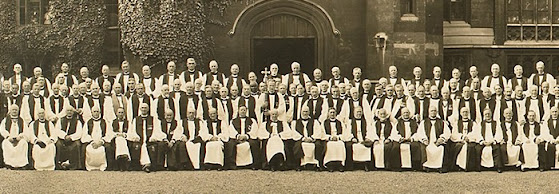Fatwa (pronounced faht-wah)
(1) In
Islam, a religious decree issued by a high authority (such as a mufti) or the ʿulama (a body of Muslim scholars who are recognized as having
specialist knowledge of Islamic sacred law and theology).
(2) In
Islam, a non-binding judgment on a point of Islamic law given by a recognized
religious authority.
1620s:
From the Arabic fatwā or fetwā (a legal ruling given by a mufti)
and related to fata (to instruct by a
legal decision). The Arabic فَتْوَى (fatwā) was the verbal noun of أَفْتَى (ʾaftā) (to deliver a formal
opinion; he gave a legal decision), مُفْتٍ (muftin) (mufti) the active participle of
the same verb. The
noun mufti, one of a number of titles in the Islamic legal and institutional
structures, dates from the 1580s muphtie
(official head of the state religion in Turkey), from the Arabic mufti (judge), the active participle
(with formative prefix mu-) of afta (to give) a conjugated form of fata.
The alternative forms are fatwah,
fetwa, fetwah, futwa & (the archaic medieval) futwah although in some early sources it appeared as fotyā (plural fatāwā) & fatāwī; in English use, it’s written usually as
fatwa. Fatwa is a noun & verb and fatwaing & fatwaed are verbs; the noun plural is fatwas or fatawa. The occasionally used adjectives fatwaesque & fatwaish are non-standard.
Apart from the work
of historians and other scholars, the word was rare in English, popularized in
the West only when, on Valentine’s day 1989, Ayatollah Khomeini issued a fatwā sentencing
to death the author Salman Rushdie (b 1947) and others associated with publishing
The Satanic Verses (1988), the charge
being blasphemy. The fatwā was revoked
in 1998. Interestingly, in purely juristic
terms, The Satanic Verses fatwā is
thought neither remarkable nor innovative, the call for extra-judicial
killings, the summary execution of those condemned without judicial process, was
well grounded in the historic provisions of Shiʿite (and Sunni) jurisprudence. What lent this fatwā its impact was it had
been issued by a head of state against the citizen of another country and
seemed thus archaic in late twentieth century international relations.
A fatwā
is the authoritative ruling of a religious scholar on questions (masāʾel) of Islamic jurisprudence either (1) dubious
or obscure in nature (shobohāt) or (2)
which are newly arisen and for which there is no known precedent (mostaḥdaṯāt) and it’s in connection with the latter category
that the word fatwā has long been regarded as cognate with fatā (young man); the sense of something new. However, the enquiry eliciting a fatwā may relate
to an existing ordinance (ḥokm) of Islamic law (particularly one unknown to the
questioner) or to its application to a specific case or occurrence which is
sufficiently different to the way something has historically been applied. In this case, the fatwā functions as an act
to clarify the relevant ordinance (tabyīn-e
ḥokm). This
can apply to something novel like new technology. The International Space Station (ISS)
operates at an altitude of 250 miles (400 km) and travels at 17,500 mph (28,000
km/h), thus orbiting Earth every ninety minutes so when a Muslim astronaut
requested guidance about the correct protocols to ensure he was facing towards
Mecca when in prayer, a Malaysian scholar issued a fatwā.
The
process of requesting a fatwā is termed esteftāʾ; the one who requests it is the mostaftī; its delivery is the eftāʾ; and the one who delivers it is the moftī. There is nothing in Islamic law which dictates
a fatwā must be either requested or provided in writing although this has
always been the common practice and certainly followed in matters of
importance. However, request and fatwā may
be delivered orally and the practice is doubtlessly widespread, especially when
merely confirming things generally known. The technical process of the fatwā
wasn’t an invention of Islam. In Roman
civil law, the principle of jus
respondendi (the right of responding) was an authority
conferred on senior jurists when delivering legal opinions; thought essentially
the right to embellish a ruling with an opinion, some historians maintain it
was even a right to issue a dissent although there’s no agreement on this. Perhaps even closer was the Jewish practice
of Responsa (in Latin the plural of responsum (answer)) which in practice translated as “ask the
Rabbi”.
As a
general principle, fatwās exist to address specific and actual
problems or uncertainties, although rulings are not infrequently sought on a
set of interrelated questions or on hypothetical problems the occurrence of
which is anticipated. A legal scholar
can thus provide what is, in effect, an advisory opinion; something generally
unknown in the Western legal tradition.
Nor are fatwās of necessity concerned purely with legal matters, doctrinal
considerations necessarily involved whenever a fatwā results in takfīr (the condemnation of individuals
or groups as unbelievers). This is a
feature especially in Shiʿite
collections of fatwās which are sometimes prefaced with a summary of essential
doctrines, intended to create concise handbooks for the common believer of both
theology and law.
A
misunderstood aspect of the fatwā is the extent to which it can be held to be
mandatory. Because of the structures of
Islam, a fatwā is not comparable to a papal bull which is an absolute ruling
from the Holy See; a fatwā is intrinsically obligatory simply because there is
in Islam not the one lineal hierarchy, it is an expression of learned opinion
which relies for its authority upon the respect afforded to the author and the
willingness of followers to comply.
That’s not to say that some strains of Islam don’t attempt to formalise
a structure which would impose that obligation.
In Shiʿism,
the authority to deliver a fatwā is generally restricted to the mojtahed (the
jurist qualified to deduce the specific ordinances of the law (forūʿ) from its sources (oṣūl), and obedience to the mojtahed of their choice (the marjaʿ-e taqlīd) is incumbent on all who
lack learned qualifications. As a
specific point of law, the ruling given in the fatwā of a mojtahed is obligatory for those who sought.
One curious aspect of the fatwās is that while the process is only partially based on anything from the Holy Quran, by definition the content of a fatwā can be based on nothing else. The theological point is that while there are Quranic verses in which the Prophet was asked for rulings (yasʾalūnaka (they ask you) & yastaftūnaka (they ask you for a ruling)), the Prophet himself is not the source of the rulings for in these versus he is instructed to say, “God provides you with a ruling” (Allāho yoftīkom); a fatwā, ultimately relying for its authority not on the scholarship of the writer but upon it being Quranic: the word of God. This relationship is made explicit in the injunction in 16:43 (“Ask the People of Remembrance (ie those learned in the Holy Quran) if you do not know”). This accounts also for the brevity of most fatwās compared with Western traditions, it being superfluous for the moftī to cite textual or other evidence simply because all that can be issued is what can easily be referenced in the in Holy Quran. It can be no other way because, under Islamic doctrine, Muhammad was the last prophet and thus, after his death in 632, God ceased to communicate with mankind through revelation and prophets; from that point onward, for all time, there are only the words of the Holy Quran.
Lindsay Lohan in hijab.
The
vexed matter of the wearing of the hijab (or any of the other variations in Women’s
“modest” clothing associated with Islam (as it is with some other faiths)) is
an example of the fatwa in operation. The
Holy Quran contains passages discussing the concept of modesty in attire (for
both men and women) but the interpretation and application of these has varied
greatly within Islam’s many strands. The
Quranic verse most commonly cited is in Surah An-Nur (24:31) where it instructs
believing women to “draw their veils over their bosoms and not display their
beauty except to their husbands, their fathers, their husbands' fathers, their
sons, their husbands' sons, their brothers, or their brothers' sons or their
sisters' sons, or their women, or their slaves whom their right hands possess,
or male attendants who lack vigor, or children who are not yet aware of the
nakedness of women.” So there’s no explicit
mention of “heads or hair” but many Islamic scholars have constructed this as a
directive for women to cover their hair when in the presence of those not
immediate family members or close relatives.
Lindsay Lohan in hijab.
It’s
not only in Islam that interpretations of religious texts can vary widely but
in the early twenty-first century (and the trend has been accelerating since
the triumpt of the 1979 revolution in Iran) it’s upon Islam where much of the
liberal West’s attention has been focused, this interest not the garments but
the allegations of coercion imposed on women.
Some in the West have even gone as far as to deny Islamic women the
possibility that in choosing to hijab they are exercising free will, suggesting
they are victims of what the Marxists call “false consciousness”. In Islamic communities, cultural, regional
and historic customs also play a significant role in how hijab is understood
and practiced which is why there have been fatwas which interpret the Quranic
verses as severely as dictating a burqa, as a head-scarf or merely a mode of
dress and conduct which could be described as “modest” or “non-provocative”.
Lindsay Lohan in hijab.
So when there are competing fatwas, a choice must be made. Were one to take a purely theoretical position, one might hold that choice would be made on the basis of an individual's personal beliefs, level of religious observance and understanding of Islamic teachings and, because within Islam there is such a diversity of opinion, a follower might be encouraged to consult with knowledgeable scholars and from that make an informed decision. However, it’s absurd to suggest that process might be followed in a state like Afghanistan which maintains a “hijab police” and enforces a dress code as specific as a military parade ground. A fatwa thus exists in its cultural, social and legal context and even in for those living in the liberal West, forces may within families or communities operate to mean the matter of choice is a rare luxury.









.jpg)









